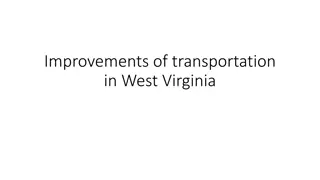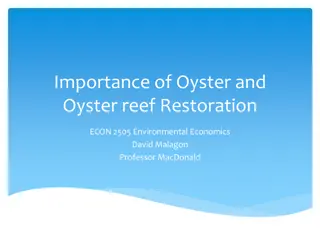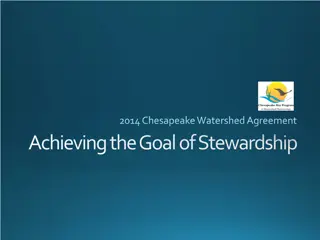Watching Seagrass Breathe
Join marine biologist Alyson Hall in her seventh-grade science project to study seagrass ecosystems. Discover the importance of seagrasses, the differences between seagrasses and seaweeds, and the two species of seagrass found in the Chesapeake Bay. Engage in activities like surveying seagrass, meas
0 views • 31 slides
Environmental Impact and Solutions: A Focus on Local Water Bodies
Explore the environmental challenges faced by local water bodies, such as Lake Accotink, due to pollution sources like non-point and point sources. Discover the importance of maintaining clean streams, with insights on dredging efforts to restore water quality. Learn how community actions can suppor
0 views • 22 slides
Reflections on Slavery: Frederick Douglass's Inner Turmoil
Within close proximity to the Chesapeake Bay, Frederick Douglass experiences a profound internal conflict while observing ships - symbols of freedom to some, but haunting ghosts to him. His longing for freedom, juxtaposed with the realities of his enslaved existence, is vividly portrayed through his
0 views • 16 slides
Lesner Bridge Aesthetic Lighting Program and Chesapeake Bay Necklace Lighting Schemes
This collection of images and descriptions showcases the aesthetic lighting programs for Lesner Bridge and the necklace lighting schemes on the edge of the Western Branch (WB) and Eastern Branch (EB) bridges in Chesapeake Bay. The programs include various themed lighting schemes for different events
0 views • 18 slides
If you are looking for Graduation Photos in South Norfolk
If you are looking for Graduation Photos in South Norfolk, Swartz Portraits is your local photographer based in Deep Creek South, Chesapeake.I have been telling stories with my camera, capturing milestone moments in people's lives, for over four deca
0 views • 6 slides
Local Government Advisory Committee and Local Leadership Workgroup Collaboration
Collaboration between the Local Government Advisory Committee (LGAC) and the Local Leadership Workgroup (LLWG) focuses on engaging with local decision-makers, implementing strategies for local engagement, and supporting the flow of information among local governments in the Chesapeake Bay watershed
0 views • 10 slides
Tidal Wetlands and Shorelines in the Chesapeake Bay: Environmental Impact and Conservation Efforts
Tidal wetlands and shorelines in the Chesapeake Bay face pressures from water, land, storms, upland development, shoreline modification, and sea-level rise. Collaborative efforts like the Fish Habitat Action Team aim to highlight the importance of these ecosystems for fisheries. Projects focus on sy
0 views • 9 slides
Chesapeake Bay Climate Resiliency Workgroup Analysis & Implementation
Increase the resiliency of the Chesapeake Bay watershed against changing climate conditions. Focus on advancing climate change goals, applying climate-smart adaptation planning, and engaging in tailored conservation approaches. Specific goals include wetlands restoration and enhancement. Utilize the
0 views • 9 slides
Factors Influencing Fish Habitat in Chesapeake Bay Watershed Workshop Report
This workshop report delves into the factors affecting fish habitat function in the Chesapeake Bay Watershed, focusing on headwaters, nontidal, tidal, and mainstem areas. It outlines the workshop process, assessment frameworks, and user needs to support restoration and management decisions. The repo
1 views • 31 slides
Historical Transportation Developments in West Virginia
Explore the evolution of transportation in West Virginia during the 19th century, including the construction of canals, turnpikes, and roads that facilitated westward expansion. Discover key projects like the Chesapeake and Ohio Canal and the James River and Kanawha Turnpike that played vital roles
0 views • 14 slides
Maryland's Draft Phase III WIP for Chesapeake Bay Spring 2019 Regional Meetings
Maryland's Phase III WIP focuses on achieving pollution reduction goals for the Chesapeake Bay by emphasizing locally-driven plans, co-benefits, and cost-effectiveness. Governor Hogan's significant investments have supported key restoration programs, with a target to reduce nitrogen levels. The stat
0 views • 19 slides
Chesapeake Bay Nontidal Monitoring Network Report
This report highlights the measurement of nitrogen, phosphorus, and suspended sediment loads at the Chesapeake Bay Nontidal Network stations, emphasizing trends and analysis conducted by various professionals. It discusses the response to restoration activities and land use changes, aiming to inform
0 views • 25 slides
Chesapeake Bay Climate Change Load Projections for 2025
The document discusses climate change projections for the Chesapeake Bay in 2025, focusing on factors like sea level rise, temperature increase, and precipitation change. It outlines proposed policy decisions, addressing uncertainties in climate change impacts on water quality and the need to incorp
0 views • 22 slides
2018-19 Bay Barometer Communications Workgroup Report
Annual report on watershed health and restoration, highlighting the lack of updated indicators and providing insights into the improved indicators concerning blue crab abundance, protected lands, public access, RPI, and SAV metrics. The report outlines the progress made in various areas within the C
0 views • 12 slides
Chesapeake Bay Program Watershed Model Overview
The Chesapeake Bay Program's Watershed Model, presented to STAC in December 2019, provides insights on long-term average pollutant loads and land use dynamics in the Chesapeake Bay watershed. The model incorporates inputs such as land use acres, BMPs, and delivery mechanisms to estimate pollutant lo
0 views • 41 slides
Coalition for Clean Water: Advocating for Chesapeake Bay Restoration
The Choose Clean Water Coalition, led by Hilary Harp Falk, is a diverse group of over 230 organizations working towards restoring rivers and streams in the Chesapeake region. Their mission includes coordinating policies and actions at all levels to ensure clean-up success. With a vision of vibrant,
0 views • 25 slides
Importance of Oyster and Oyster Reef Restoration in Environmental Economics
Oysters and oyster reefs play significant roles in environmental and economic ecosystems. Oysters filter pollutants, improve water quality, and support marine life. Economically, oyster industries provide employment and raw materials for various products like jewelry. Oyster restoration efforts cont
0 views • 14 slides
Oyster Restoration Efforts in Chesapeake Bay
Efforts are underway to restore oyster populations in Chesapeake Bay tributaries by 2025. Various workgroups, stakeholders, and scientists are collaborating to define restoration goals, develop tributary plans, conduct population surveys, and manage the restoration process. The Harris Creek tributar
0 views • 17 slides
Nutrient Trading Program Overview for NPDES Permittees
The Nutrient Trading Program in Maryland establishes a marketplace for water quality credits to meet pollutant load limits, involving sectors like agriculture, stormwater, wastewater, and more. State agencies play critical roles in registering credits, certifying trades, and ensuring compliance. Key
0 views • 24 slides
Chesapeake Bay Program Decision Framework Implementation Overview
This overview provides insights into the Chesapeake Bay Program Decision Framework Implementation, including reasons for implementation, goals, steps, outcomes, and benefits. The framework emphasizes adaptive management, accountability, goal articulation, factors affecting attainment, monitoring, as
0 views • 30 slides
Chesapeake Bay Program Strategic Science & Research Framework Update
The update presented at the STAR Quarterly Meeting on 9/16/2020 outlines initiatives in environmental literacy, online science database development, and stewardship cohorts focusing on clean water goals and monitoring strategies for the Chesapeake Bay Program. The comprehensive strategies aim to imp
0 views • 10 slides
Chesapeake Bay Climate Resiliency Workgroup Analysis & Implementation
This document outlines the goals and objectives of the Chesapeake Bay Climate Resiliency Workgroup, focusing on increasing the resiliency of the watershed to changing environmental and climate conditions. It includes strategies for monitoring, assessment, adaptation, and project goals to enhance the
0 views • 9 slides
Integrated Sediment Model for Nutrient Processes in Chesapeake Bay
This sediment model framework integrates major nutrients and key processes in a vertically integrated, zero-dimensional scheme. It is characterized by its conservative and flexible nature, with fewer parameters making adjustments easy. The model includes a scheme for POM remineralization and finds a
0 views • 8 slides
Alliance for the Chesapeake Bay 50th Anniversary Project Plan
Celebrate the 50th anniversary of the Alliance for the Chesapeake Bay by focusing on brand elevation and financial sustainability. The project plan outlines objectives, project management structure, roles, and timelines to achieve strategic priorities. Governance structures and subcommittee plans ar
0 views • 9 slides
Revisiting Adjustor Curves for Total Phosphorus Removal Rates
Based on a literature review, it was found that a 5th-order polynomial curve is a better fit than the originally used logarithmic trendline for anchor rates of percent Total Phosphorus removal related to runoff depth. The expert panel report reflects the old curves while trendline equations in FAQ d
0 views • 7 slides
Achieving the Goal of Stewardship in the Chesapeake Watershed Agreement
The Chesapeake Watershed Agreement aims to increase the number and diversity of local citizen stewards and local governments supporting conservation and restoration activities for healthy local streams, rivers, and the Chesapeake Bay. Recognizing the importance of local involvement, citizen stewards
0 views • 8 slides
Challenges and Recommendations in Implementing Trading Programs in Chesapeake Bay Watershed
Implementing trading programs in the Chesapeake Bay Watershed poses critical issues such as ensuring nonpoint source practices deliver as contracted and selecting proper baselines to affect markets. The workshop highlighted the importance of oversight and conditions for successful PS-NPS trading. Re
0 views • 12 slides
Pennsylvania's Phase III Watershed Implementation Plan
Pennsylvania's Phase III Watershed Implementation Plan focuses on reducing nitrogen, phosphorus, and sediment loading to meet Chesapeake Bay Total Maximum Daily Load requirements by 2025. The plan involves various sectors like agriculture, urban runoff, and forest areas to achieve necessary reductio
0 views • 30 slides
Chesapeake Bay STAC Overview and Key Contributions
Chesapeake Bay Scientific and Technical Advisory Committee (STAC) comprises 37 volunteers from various institutions providing scientific and technical advice to the Chesapeake Bay Program. STAC members contribute time valued at over $500,000 annually, offer recommendations, and focus on technical re
0 views • 11 slides
Evaluation of Communications Needs for Tree Planting & Maintenance at Chesapeake Riparian Forest Buffer Workshop
This evaluation project aims to gather and synthesize existing products and campaigns, along with direct feedback, to assess the communications needs of partners, practitioners, and technical service providers. The workgroup consists of members from various organizations who utilized methods such as
0 views • 14 slides
Religion's Impact on Colonial Development: A Comparative Analysis
Explore the influence of religion on the development of colonial society in New England, Chesapeake, and the Middle Atlantic regions. Compare how religion shaped political power, education, and societal structures differently, from the Puritan settlements of New England to the religious tolerance in
0 views • 8 slides






























